Go to the last entry on this page .....Go to previous entryAn attempt to get the diary going again, having 'lost' all of August to the frustration of tiredness. Amongst other things I didn't pick up a camera for several weeks. It didn't help that the month was also a disappointment weather-wise, with a distinct lack of sunshine. That seems to be becoming a regular feature of the summer holiday period. During the month we said goodbye to our Land Rover Discovery, and bought a Honda CRV instead. As we slipped into September the weather changed, giving a hint of an 'Indian Summer', just in time, so we thought, for our second trip of the year down to Cornwall, to our usual spot on the Lizard. 5 September - The first big road test for the CRV as we headed to the West Country, complete with Kayak and cameras! After the spell of warm sunny weather that started the month the journey turned out to be the wettest that we can remember for many years!
6 September - A wet morning, but I was determined to head for the beach at Porthallow and take a walk along the rocky foreshore to the right of the cove. In the days before we arrived the winds had been from the south-east, and there is always the possibility of interesting things being washed in. My hopes were raised when I spotted some old timbers with a small number of Goose-barnacles. Unfortunately, they were all dead - the timber must have been washed up at least several days ago.
On a previous visit it popped its head up out of the water right next to my kayak! The choppy sea was due to south-easterly winds that had been occurring for several days.
Although this photograph suggests that it was misty, by the time I got back to the car I was soaked. However, just being able to walk on these rocks again made it all worth it!
Once I sorted myself out we headed over to Lizard Point for lunch down at the Polpeor Café. With the rain continuing to fall, the place was full of very damp people and steamed up windows. We sat by a table that faced west, and as we ate a typical Lizard transformation took place. Through the wet windows I caught a glimpse of brightness, and by the time we finished our meal and left the café the skies had turned from grey to blue. The afternoon remained sunny and became even brighter as far as I was concerned when I spotted a pair of Choughs feeding on the cliffs to the west of the point, near their nesting cave.
By the time I collected my camera from the car they had moved from the cliff to a field where they spent the next hour feeding, and where I was able to get a few rather distant photographs,
the lack of rings on their legs confirming that this is probably the pair of adults that were the first to return here back in .
By the time we got back to the bungalow I was shattered - too tired to enjoy the sight of a brilliantly clear sky after dark, with the Milky Way standing out in a way that we never see at home. There was an interesting item in the evening news bulletins - it seems that a Scottish study into Chronic Fatigue Syndrome in children has found more evidence of a viral connection with the condition that has been so frustrating for too many years. No cure in sight yet, but at least this study gives some hope that some small progress may be made towards that goal.
7 September - Overnight it seems that some heavy showers passed over us, along with rumbles of thunder, although the day turned out dry and sunny day, although much of the morning was spent in Helston, the local town and we didn't get to the beach until the afternoon.
The wind has now moved around to the south-west, meaning that the sea was flat calm at Porthallow. However, by then I was too weary to risk heading out on the canoe. Instead, we enjoyed the unusual sight of four Swans in the cove - we can't recall seeing them there before,
and one seemed to be very inquisitive, although with no aggression - I was sitting on the gravel no more than a couple of feet from it when I took this photograph.
8 September - On another sunny morning, and with the tide very low (lowest tides of the year over the next couple of days) we headed back down to Porthallow and I got out on my kayak for the first time this holiday.
It was a case of heading off along the usual bit of coastline, stopping off several times to beach-comb in coves.
With the south-westerly breeze sometimes providing a following wind I got as far as Nare Point and its Coastal Watch station. One of the volunteers there told me that there is actually a pair of seals living on this bit of the coast although I saw no sign of them today.
During the trip I found a large Dogfish (>3ft) tangled in some netting. It was still very much alive and headed off under rocks when freed. This afternoon/evening I'm absolutely shattered - but it was worth it!
While we relaxed afterwards it was interesting to contrast the sunny conditions we were experiencing with a line of heavy showers that was affecting the Cornish coast to the east of Falmouth Bay during much of the afternoon.
9 September - Another bright, sunny morning had us heading back down to Porthallow for the low tide that would take place just before noon. With a couple of hours to wait once we had arrived, and with the sea flat calm, I couldn't resist getting out on my kayak again. Unlike yesterday, soon after I paddled out of the bay a line of cloud arrived over us rather than the lands across the bay. Fortunately we had just a few spots of rain all day.
Still weary from yesterday I didn't go far this time, just as far as the caves. At other times it's possible to paddle into this one (as well as a couple of others), but with the Spring tide approaching its lowest point there would have been a long wait to do so at this time.
When I returned to shore to explore a bit of the shore at low tide I found myself struggling to keep going - thank goodness that it is much easier to put the kayak onto the roof of the CRV than it was onto the Discovery roof rack! Anyway, I managed to take a few photographs before I had to pack the cameras away too and we headed off to Lizard Point for a meal.
To the right of the gravel beach there are just a few rock pools, but the rocky lower shore provides a good spot to search when you are in a good mood! First, the largest starfish that I've found during our Cornish holidays, measuring in excess of 15cm across. it is Marthasterias glasialis, basically a sub littoral species made accessible by the Spring tide.
This is a much smaller individual was only around 4cm across. Covered with what look like tufts of spines I think it is the Common Starfish (Asterias rubens).
It was attached to red seaweed close to a foot below the water at low tide. Unfortunately, when I collected the bit of seaweed the jellyfish detached itself. I think it is Lucernariopsis campanulata, a largely sublittoral species.
Each of the eleven arms of this star represents one individual. Each organism has a small oral siphon at the outside edge of the star, while all eleven individuals share a central exhalent siphon
10 September - Having learned my lesson yesterday, while we headed down to Porthallow again, this time the kayak stayed on the car! It was a largely cloudy day with a strong but quite mild wing blowing down the valley leading to the cove, and the sea was more or less flat calm.
To start with, a Dreadlocks Anemone waving about in the slight surges still present in the calm water,
and the iridescent blue tips of the Carragheen seaweed, although the blue colouring doesn't come out as well as I would like. Perhaps I'll try again next week.
Another picture of the colonial sea squirt Botryllus schlosseri.
My guides describe the species as rather variable, but this one certainly looks very different. If you view the large image you can also see a second picture of the central grouping that shows different oral siphons open as the individuals draw water through their bodies.
In this example the individuals appear to be more clearly defined as well as having a different colouring.
I had hoped to photograph some living bryozoans, but wasn't successful today. However, I did spot this tiny gastropod that appeared to be feeding on a patch of bryozoans. This is a species that I'll have to investigate further when I get home and have internet access once again.
As I watched for bryozoan activity on a piece of Laminaria frond I spotted some almost luminous blue spots that stood out against the brown background despite being very small (less than 3mm long). When I looked through the camera I realised that the pattern of spots was actually moving and realized that I was looking at a very small Blue-rayed Limpet that was grazing on the Laminaria. Look carefully at the large image and you can see the grazed limits around the limpet. This is the first time I've come across one of these. Why would they need such prominent markings?
We are used to seeing Cormorants diving as they fish a little way off the shore, but as the tide starts to come in it's fascinating to see them adopt a rather different approach.
I took this photograph just as the Cormorant swam out with what appears to be a blenny, caught in this way.
The very low tides at the moment uncover a normally hidden sandy area below the gravel of the beach. This picture was taken at the lowest point in the tide.
The sand hides a population of razor shells. I actually picked up a couple of empty shells but failed to photograph them! Also on the sand were numerous examples of what I think are Marbled Swimming Crabs, a small species found on sand and gravel on the lower shore and below.
11 September - Another breezy day at Porthallow with westerly winds, although it swung more northerly later in the afternoon - indicated by the movement of ships at their moorings in Falmouth Bay (the state of the tide by then would have had them facing the south-west). As happened yesterday we had a procession of clouds passing over us which brought the occasional few spots of rain, but we had none of the heavy showers that had been forecast. I took advantage of the continuing calm seas to go kayaking again. This time it was a leisurely outing with long stops in a couple of the coves just to the north of Porthallow, as far as a small headland we know as Mermaid Point. This isn't its official name, and in fact it isn't named on any of the maps that we have, but we gave it the title after an incident(!) that occurred some years ago. I was paddling along the coast, heading for Nare Head. As I rounded the point I came face to face with a trio of mermaids, young ladies with not a stitch of clothing on, poised to jump into the water - which is what they did with some high pitched yelps as I appeared! I did a quick about turn and didn't get to Nare Head that day... At low tide I was in Nare Cove and took the chance to investigate a narrow, sheltered channel between rocks which is only shallow enough to wade in during Spring tides.
Having been amazed by the neon display of the single Blue-Rayed Limpet yesterday, you can imagine my surprised when I turned over a leathery frond of Laminaria to be faced with a large group of them! I don't know how significant it is, but most of the limpets were facing in the same direction - the stalk (and holdfast) of this frond would have been below the picture if the frond was extended vertically.
And there were others on nearly every frond I checked, as well as others on fronds of Serrated Wrack. All the examples I found were of a similar size, no more than about 4mm in length, slightly larger than the one I found yesterday.
While most of the Laminaria was still submerged, a foot or so above the water, on a vertical surface were several patches of quite bright green Breadcrumb sponge (Halichondria panicea), one of the most common sponges you find on rocky seashores, especially in gullies and other sheltered spots. The example in the photograph is a thin encrustation typical of such a sheltered spot. In more exposed conditions it can be much thicker. The green colour is due to a symbiotic alga in the surface layers, and in deeper water the sponge is yellow.
The surface of the sponge is punctuated by what looks like a random distribution of raised openings, each called an Osculum (pl. Oscula). The surface of the sponge also has very many tiny openings, or pores. Water enters through these pores, and leaves via the Oscula, with the flow of water maintained by specialized cell with hairs which also filter out food particles.
Next to the sponge, and in a few places growing on it, was a very delicate red seaweed which could be Lomentaria articulata, a common species that usually grows to no longer than around 10cm in length. Here, a small example is developing between the oscula of the sponge.
This is a species that is largely restricted to the south-west of Britain, the northern limit of its distribution. The size of this individual suggests that it is a female, and may be at least four years old. Cushion-stars are all males when they first mature at 2 years old and measure about 10mm across. Then they change to female two years later when about 20mm across. They can live for around 7 year.
Moments later a noisy trio of Oystercatchers appeared from behind the rocks, flying out to sea and followed by a Curlew, the first one I've seen this holiday.
12 September - A mainly sunny, but slow, slow day, with us not setting out until after 3pm when we headed down to Lizard Point for a meal, after which I went for a walk to see if the Choughs were about. I spotted the pair in the same field as last week, but this time much closer to the footpath. Great, I thought, but then I noticed someone watching them over a gate at the top of the field. That person's movement (and bright top) must have disturbed the Choughs and they flew further across the field. Nevertheless, I walked around to the spot that I photographed them from last week and waited.
Afterwards they spent some time back on the cliffs where I saw a bit of bonding behavior in the form of courtship feeding before they headed back over the fields and away from the area.
13 September - A trip to Porthleven, a harbour on the west coast of the Lizard (no photographs taken) before heading back to Lizard Point for a meal.
14 September - A damp, misty morning helped us decide to take a trip to Falmouth where we visited the National Maritime Museum - a fascinating place which will be well worth another visit in the future.
15 September - Another day on which we spent the morning down at Porthallow before headed to Lizard Point for a meal. On this occasion I decided to start off by taking a couple of pictures of the cove itself from positions used to produce postcard images back in the early 20th century.
On the skyline (top-right) you can just make out the village of St. Keverne, the 'hub' of this part of the Lizard, and linked to the cove by a very narrow, winding road.
I extended this view to include the piece of coast I paddle along, as well as the distant shores on the other side of Falmouth Bay.
Here I'm looking back towards the cove.
The continuing calm conditions, along with the neap tides meant that landing anywhere along the coast was a gentle business,
and the complete lack of any swell meant that paddling into the caves was as easy as it could get.
While there seems to have been a distinct lack of Buzzards around Porthallow during this holiday, every trip on the kayak has been rewarded with sightings of Oystercatchers, and several Curlews. It has been a bit frustrating that I haven't been able to get a good view of the Curlews before they see me. I must get myself a pair of waterproof binoculars before next year's visits.
16 September - Today started with a return trip to Porthleven (to buy knitting yard) before heading for Lizard Point.
There were a bit too far away, but my hopes were raised when one of the pair flew closer to me. Here, it started to feed but also frequently called and displayed in the direction of its partner before gradually moving back over to join the other bird once again. A short time later the pair were disturbed by a group of Jackdaws and headed to the cliffs.
I headed back to the cliff top path and joined another pair of photographers. We soon found the pair together on a small ledge near the nesting cave, where they spent several minutes preening before heading to other spots along the cliff. At this point I headed back to the cafe for a meal!
In the water below the cliff-top car park a couple of seals entertained the humans by doing very little more than just resting at the surface. This one had particularly bold markings,
and its frequent yawns suggested that it was either weary or bored!
17 September - With the sea remaining calm, and despite it being mainly cloudy I took the chance to get out on the kayak for one last time this holiday, in the longest session so far.
Yet again the Oystercatchers and Curlews made themselves seen and heard, and several Cormorants waited until I passed close by before they too headed off. I was able to get quite close to this one although I didn't risk paddling around the rock for a better view.
Another bird worth noting was a Swan. At the beginning of the holiday I mentioned the four Swans in Porthallow Cove. While there have been Swans there every time we've been there over the last two weeks, the number has actually varied, and today there were only two, and we have not see any of them flying. Today, while I was out on the kayak I spotted a third one, way out from shore and swimming towards the cove. It seems that they move between Porthallow and the area north of Nare Point, possibly Gillan Creek or the Helford River. Sheila confirmed that the Swan joined the pair in the cove a short time later. Another fascinating sighting was of a fish that I saw jump out of the water. This isn't an unusual sight, the fish usually escaping a predator. However, this fish remained out of the water for a long time, travelling at least 10 - 15 yards with just its tail in contact with the water. It seemed to be a long and skinny fish but was too far away to get a good view. The highlight of the trip, in fact of the holiday, was an amazing episode that occurred early during the outing while I was several hundred yards off shore. I suddenly became aware that there were Swallows flying about me. When I stopped paddling I realised that there were literally hundreds of them, spread out over quite a large area, and flying low over the water. While they were clearly feeding, it was also obvious that the group were moving south. I called Sheila on the radio and she watched them as they flew past. The coast on the south side of the cove sticks out a bit towards the east, and some of the birds moved over land, although many clearly remained over water. I can only speculate, but their feeding may have been linked to the westerly breeze that was blowing. This sweeps down the valley leading to Porthallow and whenever I'm kayaking in these conditions I come across quite a few insects that have been blown out from land. Once the group had passed I saw very few stragglers, and just one or two that seemed to fly back north. Given the timing of what I saw I must assume that this was a mass migratory movement.
Once all that excitement had passed I returned to the kayaking, once again taking advantage of the 'millpond' conditions and friendly tide levels to visit spots that are usually less friendly to paddle into,
as well as the caves that I can't keep away from.
18 September - A cloudy day on which the morning was spent packing ready for our return home the next day. This task more or less completed, we headed down to Lizard Point for the rest of the day. I headed off along the cliff path to spot the Choughs one last time, but this time all I saw was a distant view of the pair heading off across the fields and away to another part of the coast to the west of us.
I satisfied myself with a couple of hand-held shots of this small bird before it too disappeared from sight. It appears to be a juvenile. At first I wondered if it was a young Robin, but I don't think it is. However, beyond that possibility I'm at a bit of a loss!
Click on images to see larger version |
|
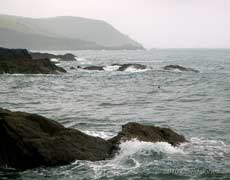 Heading
over to the other side of the cove I spotted a seal, something I have seen
here several times over just the last couple of years. Hopefully I will come
across it when I'm out on the kayak. You can just make it out
centre-right in this picture
Heading
over to the other side of the cove I spotted a seal, something I have seen
here several times over just the last couple of years. Hopefully I will come
across it when I'm out on the kayak. You can just make it out
centre-right in this picture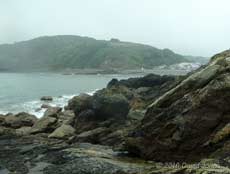
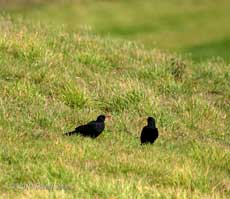
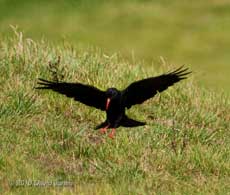
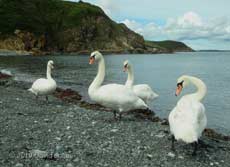
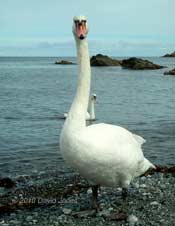
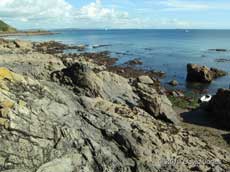
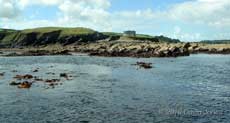
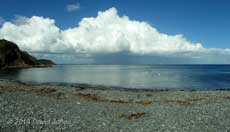
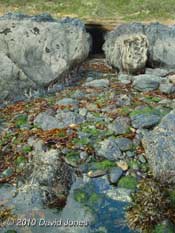
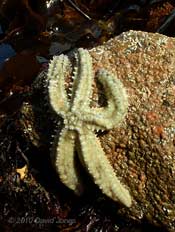
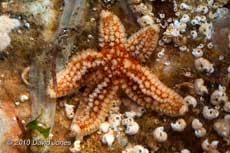
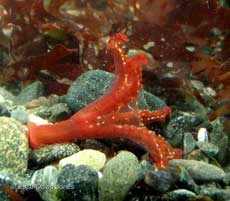 One
of my main aims during my search was to find some stalked jellyfish, having
found some very small ones in previous years. This time I found just one,
although at about 35mm tall it is the biggest I've found.
One
of my main aims during my search was to find some stalked jellyfish, having
found some very small ones in previous years. This time I found just one,
although at about 35mm tall it is the biggest I've found. 
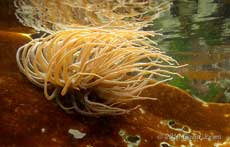 With
the aim of taking a few more photographs than I did yesterday I returned to
the same spot that I collected yesterday's specimens.
With
the aim of taking a few more photographs than I did yesterday I returned to
the same spot that I collected yesterday's specimens.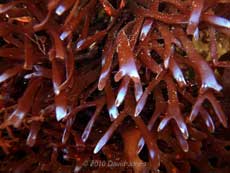
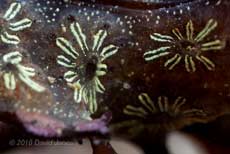
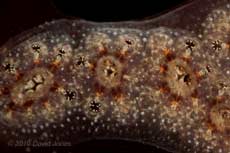
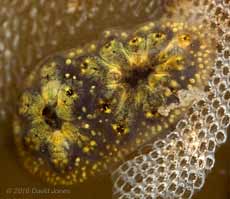
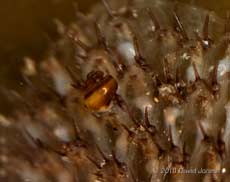
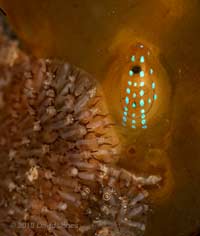
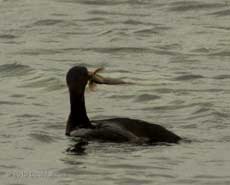 I
sometimes watch one right at the water's edge on the stony foreshore where
it watches as the sea water moves in around the stones. The bird appears to
be waiting to grab any fish that had remained under a stone as the tide
receded and which was now able to leave its refuge once more.
I
sometimes watch one right at the water's edge on the stony foreshore where
it watches as the sea water moves in around the stones. The bird appears to
be waiting to grab any fish that had remained under a stone as the tide
receded and which was now able to leave its refuge once more.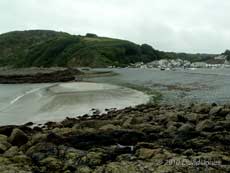
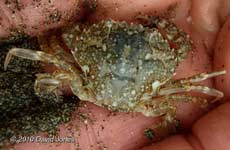
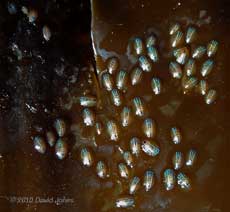
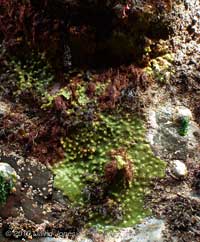
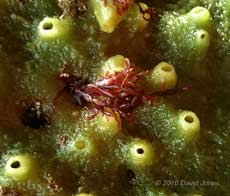
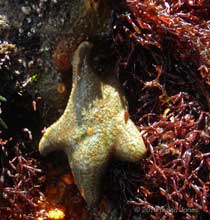 And
another starfish, this time a Cushion-star (prob. Asterina gibbosa),
measuring close to 3cm across)
And
another starfish, this time a Cushion-star (prob. Asterina gibbosa),
measuring close to 3cm across)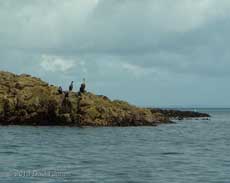 Finally,
before heading back to Porthallow I paddled to Mermaid Point, trying to get
close to a group of Cormorants. There is no change of a close approach, and
you know that they are about to leave when they defecate. Moments later,
rather than fly off they jumped into the water and dived!
Finally,
before heading back to Porthallow I paddled to Mermaid Point, trying to get
close to a group of Cormorants. There is no change of a close approach, and
you know that they are about to leave when they defecate. Moments later,
rather than fly off they jumped into the water and dived!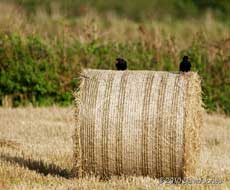 A
few minutes later their heads started appearing over the top of a ridge.
However, rather than coming closer they took off and flew to an adjacent
field where hay has recently been cut and baled, landing on one of those
bales. They stayed on it just long enough for me to take a couple of
photographs before they flew down into the stubble where they all but
disappeared for a while.
A
few minutes later their heads started appearing over the top of a ridge.
However, rather than coming closer they took off and flew to an adjacent
field where hay has recently been cut and baled, landing on one of those
bales. They stayed on it just long enough for me to take a couple of
photographs before they flew down into the stubble where they all but
disappeared for a while.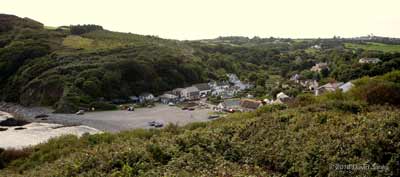 This
first one, from the coastal path above the cliff on the north side of the
cove.
This
first one, from the coastal path above the cliff on the north side of the
cove.  This
second view was taken from just above our car, which you can see parked near
the water on the south side of the beach.
This
second view was taken from just above our car, which you can see parked near
the water on the south side of the beach.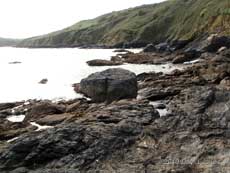 Then
it was a out onto the flat sea for a relaxing paddle, only as far as the
first small headland on the north side.
Then
it was a out onto the flat sea for a relaxing paddle, only as far as the
first small headland on the north side.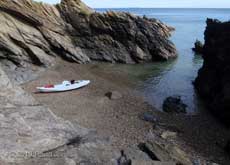
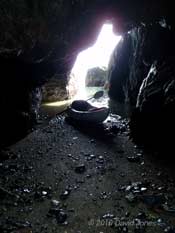
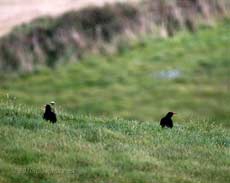 The
Chough pair seem to be quite predicable at the moment. Once again the pair
landed in the same spot to feed where I'd already photographed them on the
6th and the 12th.
The
Chough pair seem to be quite predicable at the moment. Once again the pair
landed in the same spot to feed where I'd already photographed them on the
6th and the 12th.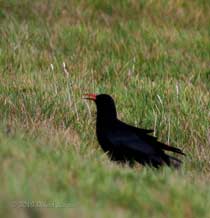
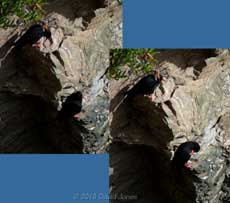
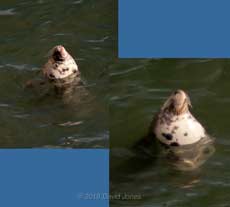
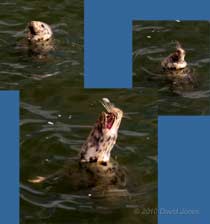
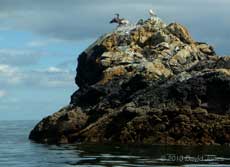
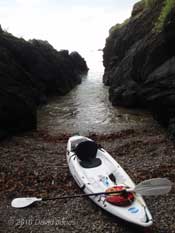
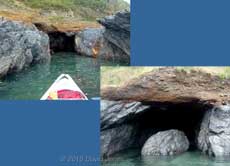
 And
finally, the calm water allowed me to take pictures that I could paste
together to give a kayaker's eye view of Porthallow Cove.
And
finally, the calm water allowed me to take pictures that I could paste
together to give a kayaker's eye view of Porthallow Cove.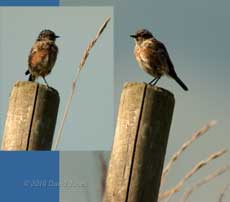
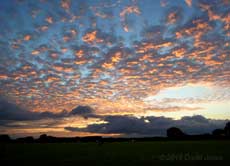 19
September - This was the view of the dawn skies over the field just
behind our bungalow as we made an early start on the long journey home after
a better holiday that I had hoped for.
19
September - This was the view of the dawn skies over the field just
behind our bungalow as we made an early start on the long journey home after
a better holiday that I had hoped for.